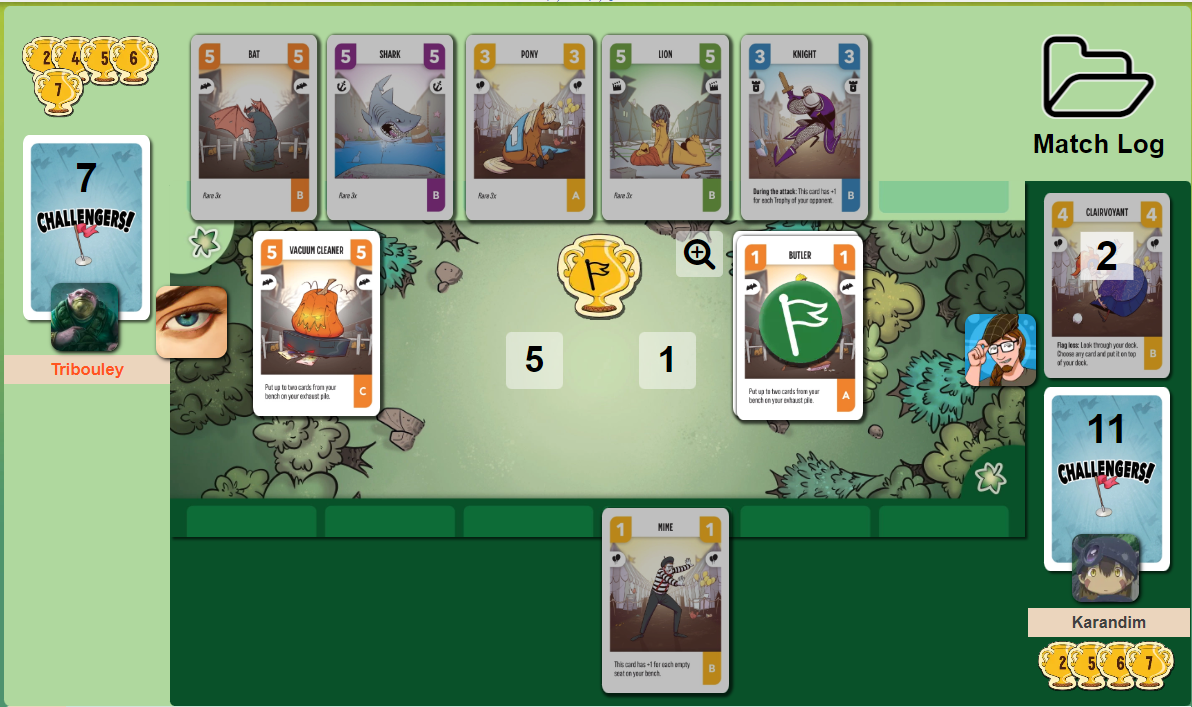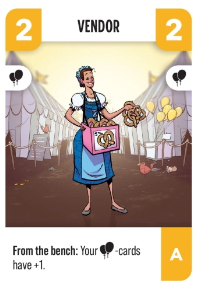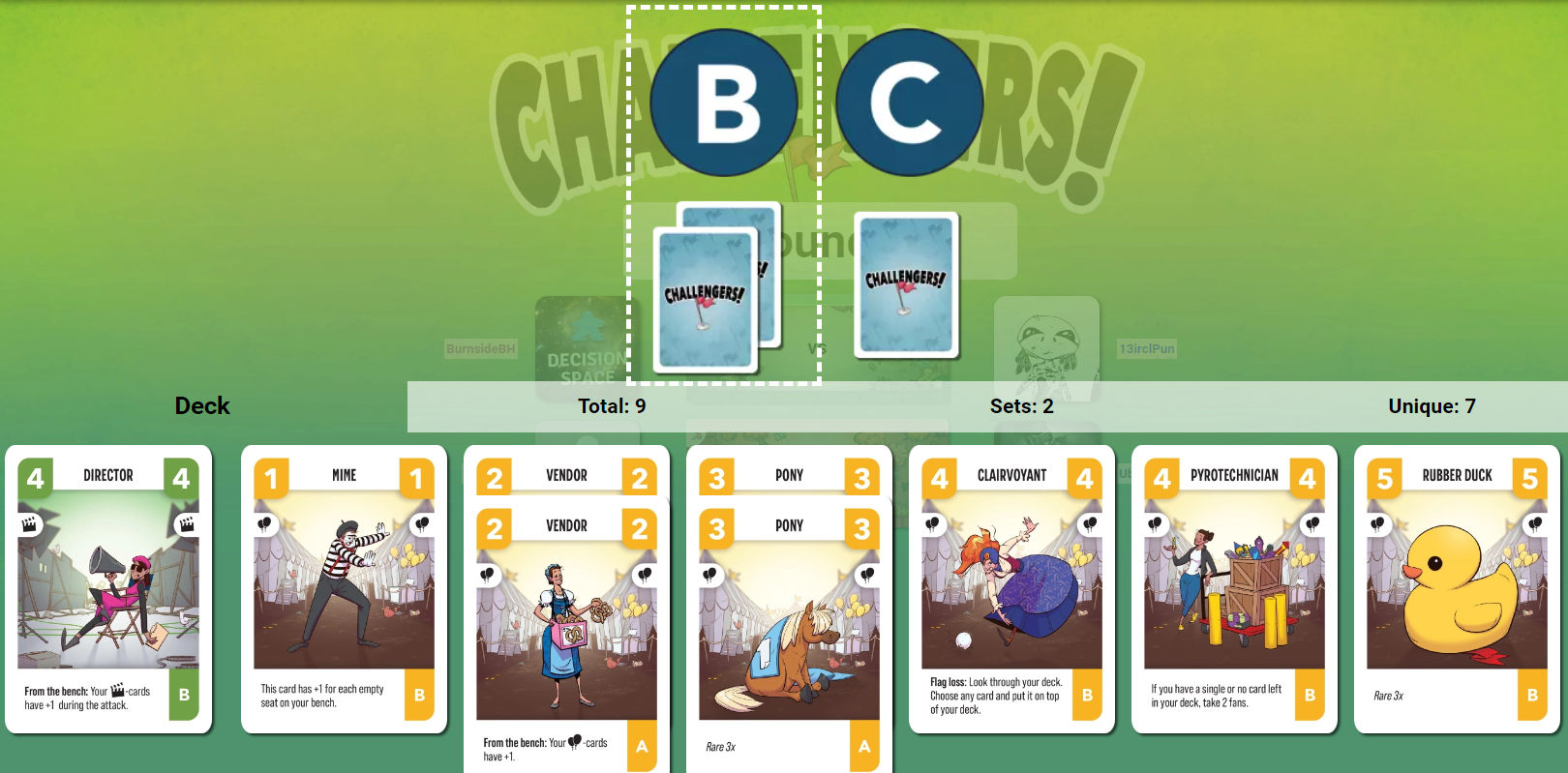Eight Tips to Challenge the Competition in Challengers!
by Brendan Hansen
Challengers! is an auto-battler style card-driven drafting game that was recently nominated for the Kennerspiel des Jahres 2023. I first had the opportunity to play this game at Geekway to the West in St. Louis a few weeks ago and it hit the table in a raucously fun game at the max player count–eight players.
Challengers! feels something like a gamery party game. The entire game is structured in the style of a round robin tournament in which players do a little drafting, battle an opponent, hone their deck and continue on for seven delightful matches (with an exciting finals for the two highest placing players). It’s one part deck builder, one part drafting game, one part card game tournament simulator, and one part auto-battler. While Challengers! Isn’t the heaviest game around I was crestfallen after my in-person play because I knew it’d be tough to get a full table together to play frequently.
Luckily, Challengers! is on Board Game Arena (in beta currently) so the party can be any time and any place when you have twenty minutes to spare. There’s tremendously interesting tradeoff decisions in the drafting, strategic choices in deck archetypes to pursue, and neat sequencing decisions during the battle phase depending on the deck you build, which really enhance the experience. It’d be easy to come away from a first play of Challengers! thinking it was a more trivial game than it’s revealed itself to be after more than twenty plays. In hopes of encouraging more people to try out this delightful game that’s a candidate for my game of the year I wanted to share a short list of beginner tips to get you started. If you want to read the brief rulebook first you can do that here.
Stay Open
Challengers! is a small pool drafting game. Players draft in ‘packs’ of five cards or fewer. This means that going into a game with a specific strategy in mind can be problematic–it’s unlikely you’ll draw the cards you’re looking for. Furthermore, because you only have a handful of opportunities to upgrade your deck you’ll want to tactically pivot to take the best path forward each time. Staying open to shifting strategies at all points in the game will yield better results.
Play your best seven sets
Your bench has six seats. This means you can stack up six different unique card types of your bench without losing to an overfilled bench. Most of the time this means you will play your seven best sets of cards–I say sets as you’ll be building pairs and larger sets to try to increase your deck strength overall.
If you’re not sure about if you should cut your deck size down in the early to mid-game, try to keep your deck to seven unique card types or less.
There are expectations to this however, if you’re playing cards from the Haunted House set like Butler and Vacuum Cleaner that clear out your bench you can afford to push it a bit more. I tend to play in a risk averse manner but each copy of a card like this gives you about 1.5 cards worth of extra room in your deck for different card types.
+1s and +2s are meaningful, until they’re not
In the early game small bonuses that grant +1 and +2 are often the deciding factor. By mid game however these effects often stop being worth keeping around unless you’ve tracked down duplicates or are building around cards from deck B like Director or Band. Boosting effects stack in Challengers! and duplicates are already great in Challengers! thanks to the bench mechanism. Don’t be skittish about building your deck around an early core of synergistic boosting cards like A.I. or Vendor.
Cut and draft to increase the overall cumulative power of your deck
When making deck building decisions it’s important to think about the cumulative power value of your deck (the value of all the power on all your cards added together). While this isn’t the only thing that should be guiding your drafting and cutting decisions it’s a good heuristic that will keep you on track. For example:
Keeping a pair of 3s is on average better than keeping one 5
Likewise, taking a pair of two 5s is on average better than taking a 7
Finally, remember to break this heuristic too. A pair of 3s with a useful effect can be better than a vanilla (no effects) 7
You won’t always beat worse decks and you won’t always lose to better decks
There’s a lot of ‘noise’ in evaluating win/loss data in a high variance game like Challengers!. Card draw order can be tremendously impactful (though the drafting decisions absolutely reward stronger players). Try to understand when you lose to an opponent who benefited from good luck vs when you lose to a stronger deck. Absorb knowledge from the latter, walk away from the former knowing it’s a high variance game and that’s that.
Take the flag as efficiently as possible when given a choice
Some cards like Sailor, Juggler, Reporter, Clairvoyant, Bumper Car, and others help you control what cards will appear next and/or at the end of the round. These cards can be quite powerful as they’re a tool to reduce variance overall for that reason I value these effects highly. When utilizing them, try to trade for the flag as evenly as possible, don’t ‘overspend’ on how much power you need to take back the flag if you don’t have to. It’s okay to take a moment to think these sequencing decisions through as the decisions can be quite complex once you see the draw order of the deck and have a sense for the type of deck your opponent is playing. This is especially the case when you have multiple of these types of effects in your deck.
Build for the late game
Players get significantly more fans (points) for winning later round matches than in the early rounds. It’s nice to pick up a few fans in rounds 1, 2, and 3 but it’s more important to win rounds 4 and onwards if you have your eyes set on the champion’s seat. Stay open and play the best deck you’re dealt, even if that means abandoning a strategy that was working in the early rounds. Challengers! is a game about tactically pivoting and making interesting mid-game deck building decisions for marginal advantage.
Don’t be afraid to pick from the lesser stack
The decks you draft from escalate in power through the course of the game. Deck A (early game) is meaningfully weaker than Deck B (mid game) and the same is true of Deck B and Deck C (late game), however, let’s go back to that same refrain, duplicates are strong in Challengers!.
If you are dealt a few strong A or B deck cards during the transition from early to mid game or from mid game to late game it can absolutely be the right decision to take from the ‘weaker’ stack search for duplicates. In this example I drew into a lot of strong B cards in this Funfair deck that I would benefit from having copies of, so in this case I opted to continue to draw from Deck B rather than pulling a single card from Deck C.
Looking for more Challengers! content? Check out Episode 121 of Decision Space for our fresh thoughts on our initial play of Challengers! At Geekway to the West.





